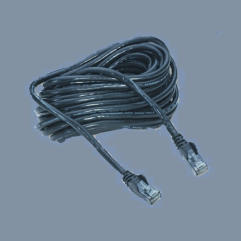


© Estwald ISI 2015 - 2025


Estwald’s
Information System Infrastructures

Rules of an Ethernet Network
At this time there are four Ethernet speeds, 10 megabits per second (Mb/s), 100
Mb/s, 1000 Mb/s or 1 gigabit per second (Gb/s), and 10,000 Mb/s or 10 Gb/s. A bit (b) is
either a one or a zero, not to be confused with a byte (B) which is eight bits of ones and
zeros. In the digital world a lower case ‘b’ and an upper case ‘B’ matter. Ethernet can pass
from 10 million bits to 10 billion bits of data per second depending upon the wire and
network devices used.
The length of an Ethernet cable must be greater than 1 meter and less than 100
meters. In English that’s 3 ft. 4 in. and 328 ft. respectively. Please note that the minimum
is not 3 ft. A 3 ft. cable may cause packet collisions and reduce the overall speed of the
network. This is particularly true if cheaper equipment with lower quality components are
being used. If you are using cables of less than 4 ft. replace them with 4 ft. cables.
The cable consists of 4 shielded twisted wire pairs with RJ-45 male connectors on either end. Cables come in four
categories depending upon the purity of the metal in the wire and the properties of the insulation and shield materials. CAT 3
cable can only be used for 10 Mb/s speeds. CAT 5 can be used for 100 Mb/s or slower, CAT 5e for 1 Gb/s or slower, and CAT 6
for 10 Gb/s or slower. The category of the cable should be printed on the outer plastic sleeve.
The final rule relates to the number of switches/hubs there can be in a network. Four switches/hubs can be daisy chained
in a network. Of these four, only three can be populated with clients/servers. This means that one of the four switches must be
used strictly as a bi-directional repeater. I have never found a good explanation for this requirement and I have asked a number
of technocrats including several Ph D’s, but it is in the specification so don’t do it.
It is acceptable to connect a higher speed network device or cable to a lower speed network device or cable but data will
pass between the ports at the slowest rated speed of the mismatched parts.
















